Leading Change: Management Process, Strategies, and Implementation
VerifiedAdded on 2024/04/24
|13
|1964
|80
Essay
AI Summary
This essay provides a comprehensive overview of organizational change management, detailing the change management process involving identification, managing, and reinforcing change. It explores strategies for communicating and embedding change, emphasizing clarity, commitment, capability, and sustainment. The essay identifies factors provoking organizational change, including competition, technology, growth desires, efficiency needs, and government regulations. It discusses the change project cycle plan, highlighting initiation, planning, execution, and control. Furthermore, the essay examines ways to promote the benefits of change through effective communication, strategies, and employee collaboration. It differentiates between internal and external driving forces of change and common pitfalls in implementation, such as lack of systematic changes and poor communication. The role of change agents, the risks of hiring external consultants, and the importance of regular evaluation are also discussed, concluding with potential barriers to organizational change and strategies to address them. Desklib offers more resources for students.
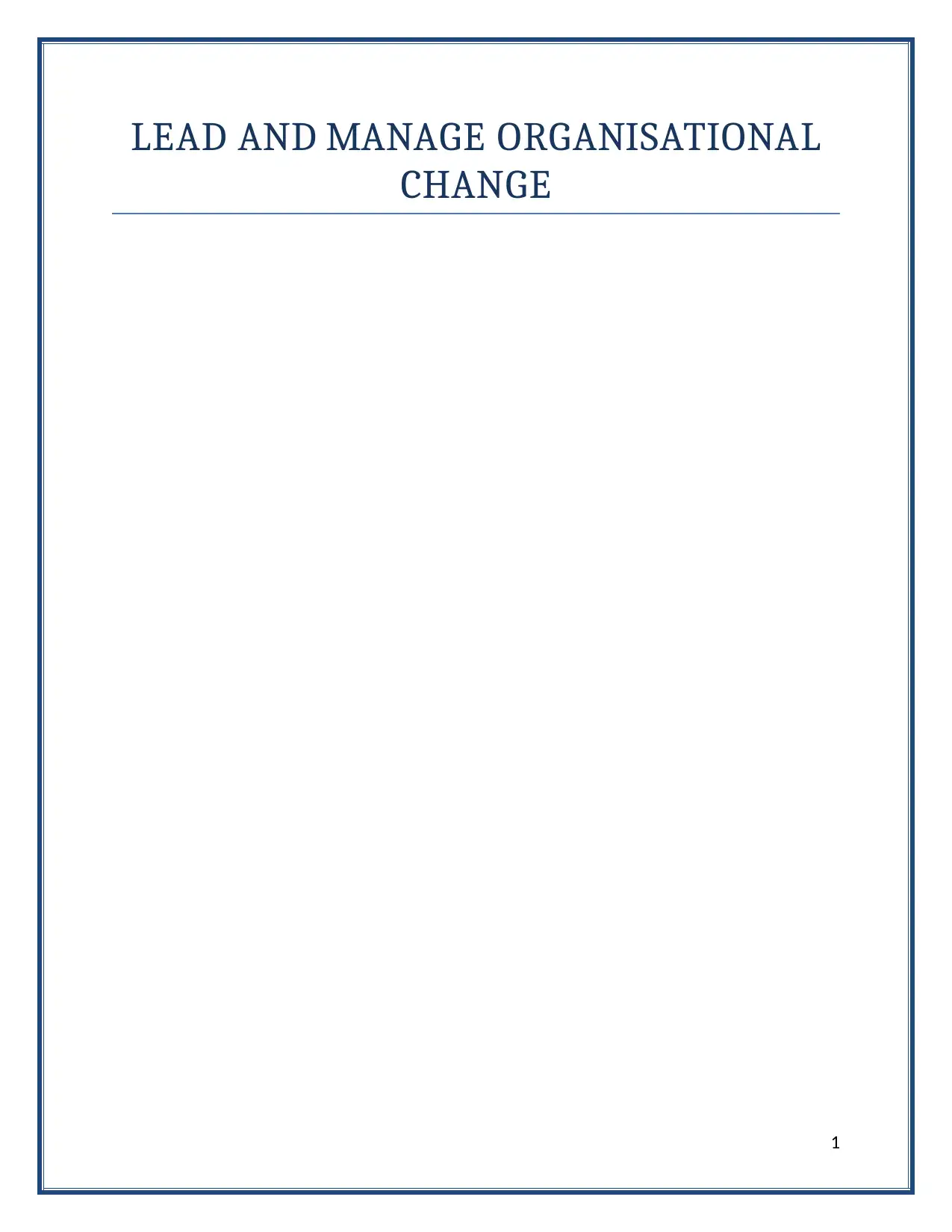
LEAD AND MANAGE ORGANISATIONAL
CHANGE
1
CHANGE
1
Paraphrase This Document
Need a fresh take? Get an instant paraphrase of this document with our AI Paraphraser
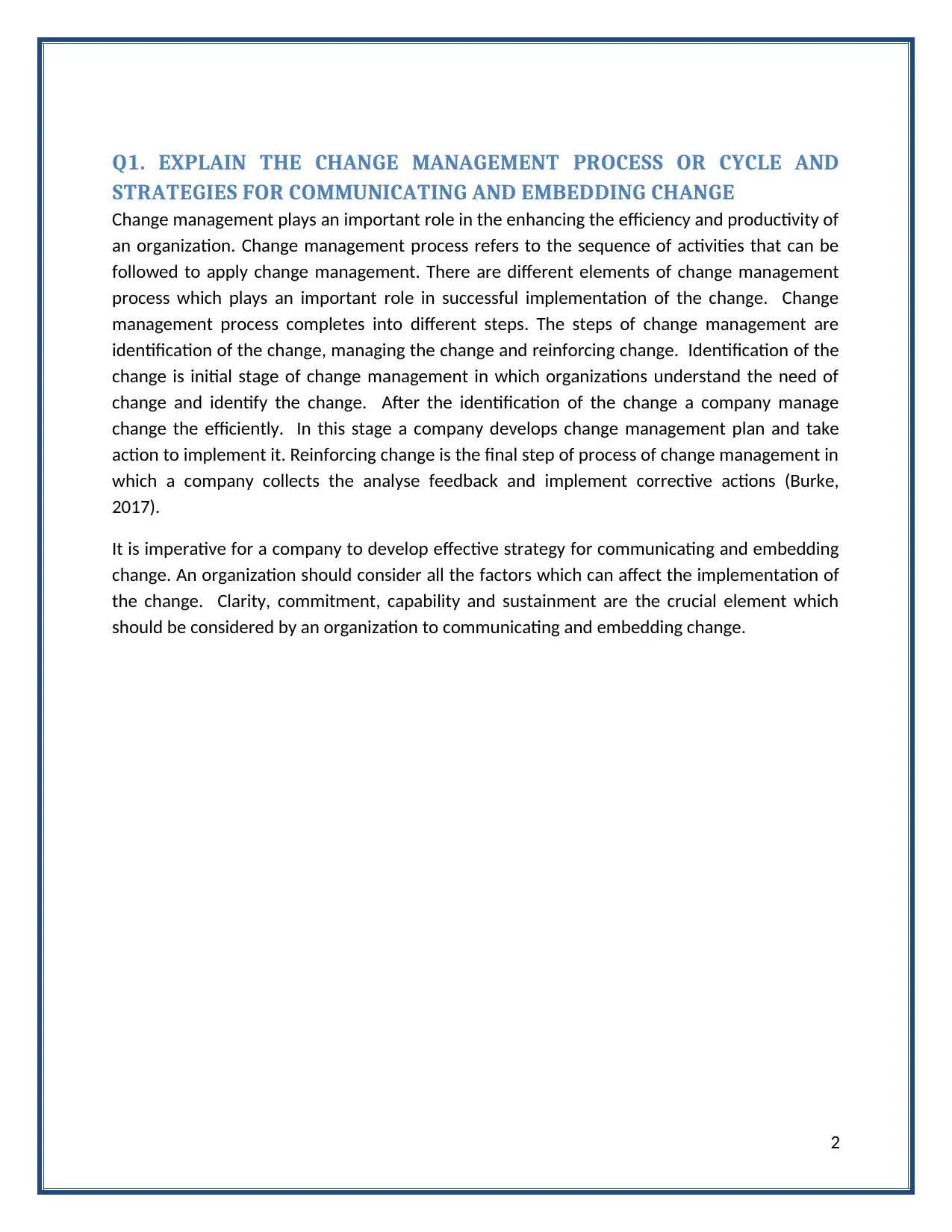
Q1. EXPLAIN THE CHANGE MANAGEMENT PROCESS OR CYCLE AND
STRATEGIES FOR COMMUNICATING AND EMBEDDING CHANGE
Change management plays an important role in the enhancing the efficiency and productivity of
an organization. Change management process refers to the sequence of activities that can be
followed to apply change management. There are different elements of change management
process which plays an important role in successful implementation of the change. Change
management process completes into different steps. The steps of change management are
identification of the change, managing the change and reinforcing change. Identification of the
change is initial stage of change management in which organizations understand the need of
change and identify the change. After the identification of the change a company manage
change the efficiently. In this stage a company develops change management plan and take
action to implement it. Reinforcing change is the final step of process of change management in
which a company collects the analyse feedback and implement corrective actions (Burke,
2017).
It is imperative for a company to develop effective strategy for communicating and embedding
change. An organization should consider all the factors which can affect the implementation of
the change. Clarity, commitment, capability and sustainment are the crucial element which
should be considered by an organization to communicating and embedding change.
2
STRATEGIES FOR COMMUNICATING AND EMBEDDING CHANGE
Change management plays an important role in the enhancing the efficiency and productivity of
an organization. Change management process refers to the sequence of activities that can be
followed to apply change management. There are different elements of change management
process which plays an important role in successful implementation of the change. Change
management process completes into different steps. The steps of change management are
identification of the change, managing the change and reinforcing change. Identification of the
change is initial stage of change management in which organizations understand the need of
change and identify the change. After the identification of the change a company manage
change the efficiently. In this stage a company develops change management plan and take
action to implement it. Reinforcing change is the final step of process of change management in
which a company collects the analyse feedback and implement corrective actions (Burke,
2017).
It is imperative for a company to develop effective strategy for communicating and embedding
change. An organization should consider all the factors which can affect the implementation of
the change. Clarity, commitment, capability and sustainment are the crucial element which
should be considered by an organization to communicating and embedding change.
2
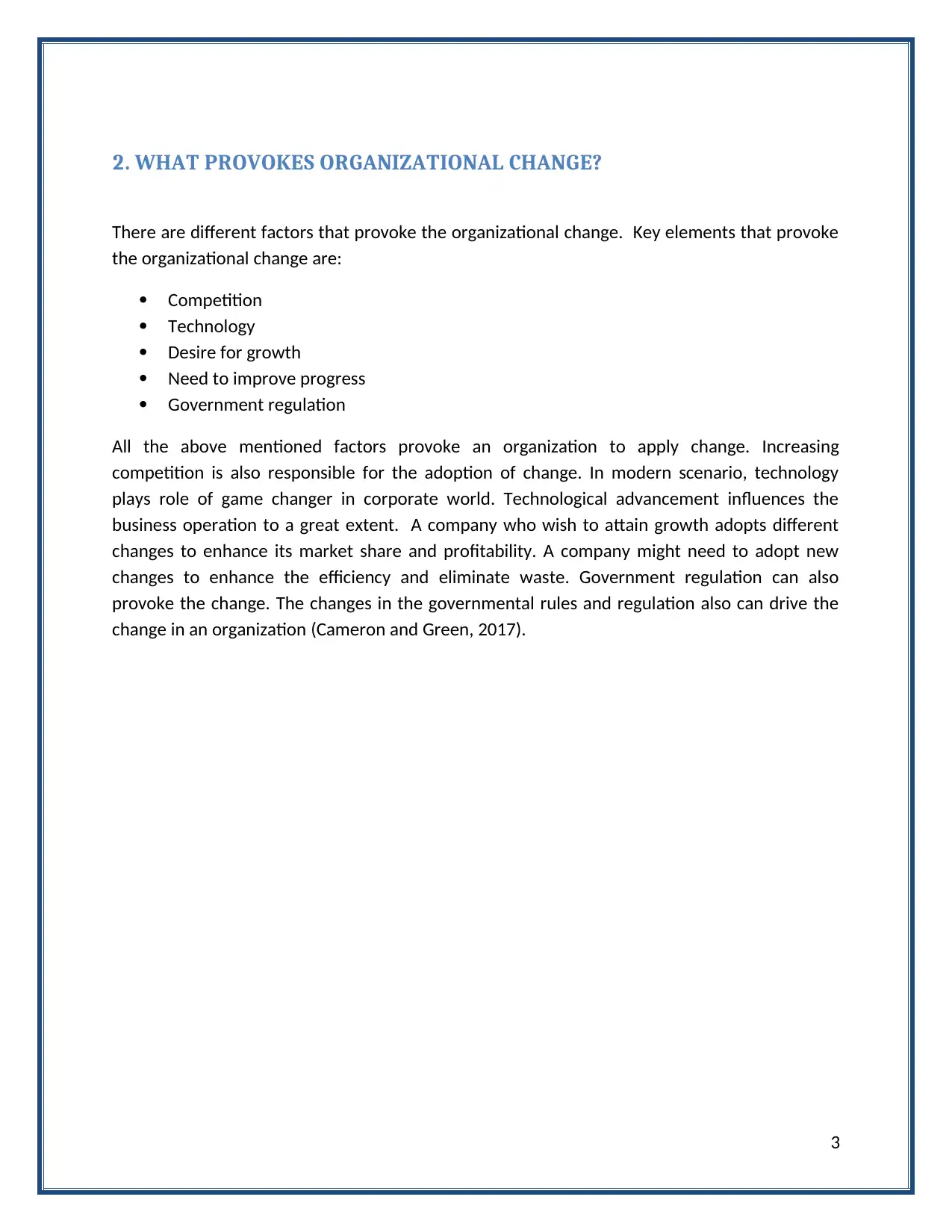
2. WHAT PROVOKES ORGANIZATIONAL CHANGE?
There are different factors that provoke the organizational change. Key elements that provoke
the organizational change are:
Competition
Technology
Desire for growth
Need to improve progress
Government regulation
All the above mentioned factors provoke an organization to apply change. Increasing
competition is also responsible for the adoption of change. In modern scenario, technology
plays role of game changer in corporate world. Technological advancement influences the
business operation to a great extent. A company who wish to attain growth adopts different
changes to enhance its market share and profitability. A company might need to adopt new
changes to enhance the efficiency and eliminate waste. Government regulation can also
provoke the change. The changes in the governmental rules and regulation also can drive the
change in an organization (Cameron and Green, 2017).
3
There are different factors that provoke the organizational change. Key elements that provoke
the organizational change are:
Competition
Technology
Desire for growth
Need to improve progress
Government regulation
All the above mentioned factors provoke an organization to apply change. Increasing
competition is also responsible for the adoption of change. In modern scenario, technology
plays role of game changer in corporate world. Technological advancement influences the
business operation to a great extent. A company who wish to attain growth adopts different
changes to enhance its market share and profitability. A company might need to adopt new
changes to enhance the efficiency and eliminate waste. Government regulation can also
provoke the change. The changes in the governmental rules and regulation also can drive the
change in an organization (Cameron and Green, 2017).
3
⊘ This is a preview!⊘
Do you want full access?
Subscribe today to unlock all pages.

Trusted by 1+ million students worldwide
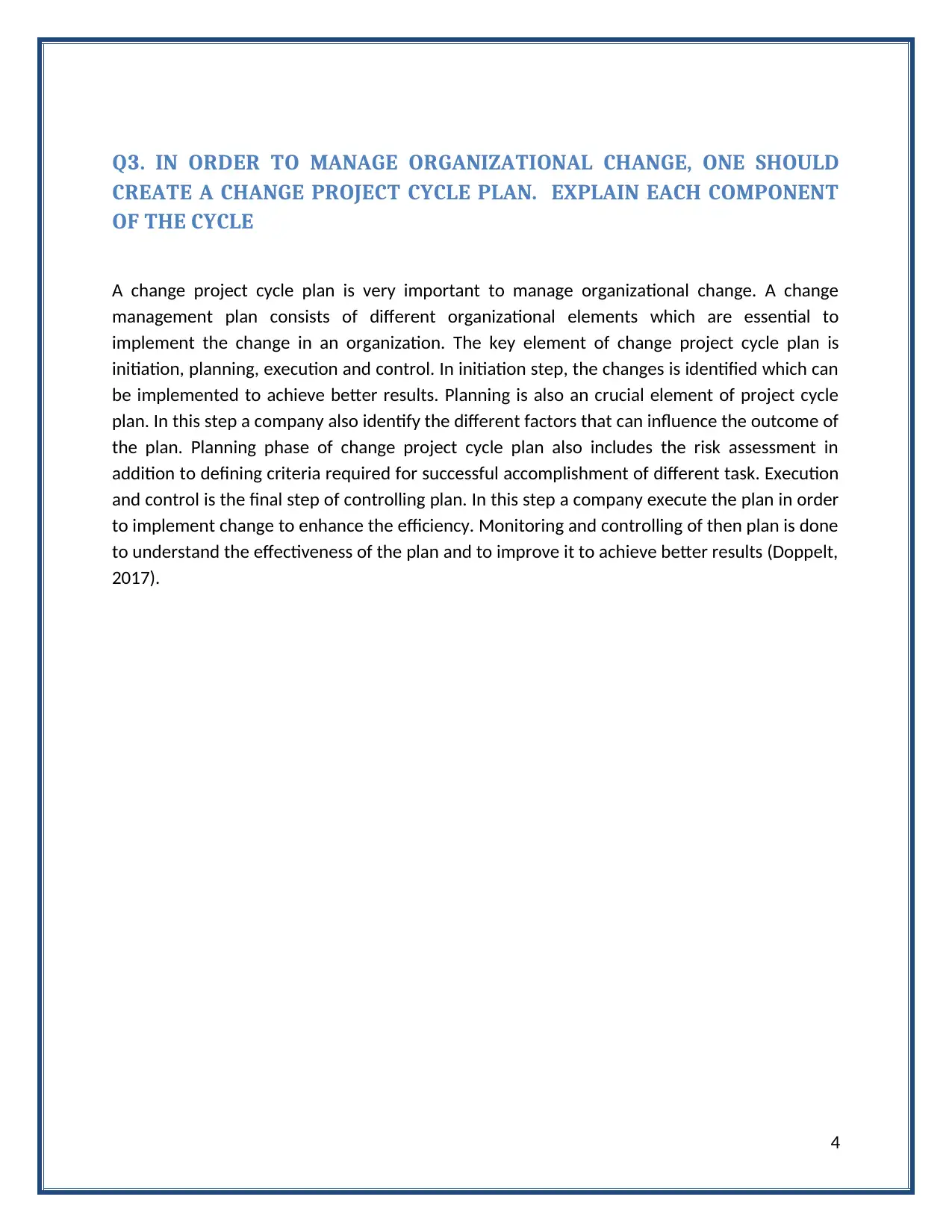
Q3. IN ORDER TO MANAGE ORGANIZATIONAL CHANGE, ONE SHOULD
CREATE A CHANGE PROJECT CYCLE PLAN. EXPLAIN EACH COMPONENT
OF THE CYCLE
A change project cycle plan is very important to manage organizational change. A change
management plan consists of different organizational elements which are essential to
implement the change in an organization. The key element of change project cycle plan is
initiation, planning, execution and control. In initiation step, the changes is identified which can
be implemented to achieve better results. Planning is also an crucial element of project cycle
plan. In this step a company also identify the different factors that can influence the outcome of
the plan. Planning phase of change project cycle plan also includes the risk assessment in
addition to defining criteria required for successful accomplishment of different task. Execution
and control is the final step of controlling plan. In this step a company execute the plan in order
to implement change to enhance the efficiency. Monitoring and controlling of then plan is done
to understand the effectiveness of the plan and to improve it to achieve better results (Doppelt,
2017).
4
CREATE A CHANGE PROJECT CYCLE PLAN. EXPLAIN EACH COMPONENT
OF THE CYCLE
A change project cycle plan is very important to manage organizational change. A change
management plan consists of different organizational elements which are essential to
implement the change in an organization. The key element of change project cycle plan is
initiation, planning, execution and control. In initiation step, the changes is identified which can
be implemented to achieve better results. Planning is also an crucial element of project cycle
plan. In this step a company also identify the different factors that can influence the outcome of
the plan. Planning phase of change project cycle plan also includes the risk assessment in
addition to defining criteria required for successful accomplishment of different task. Execution
and control is the final step of controlling plan. In this step a company execute the plan in order
to implement change to enhance the efficiency. Monitoring and controlling of then plan is done
to understand the effectiveness of the plan and to improve it to achieve better results (Doppelt,
2017).
4
Paraphrase This Document
Need a fresh take? Get an instant paraphrase of this document with our AI Paraphraser
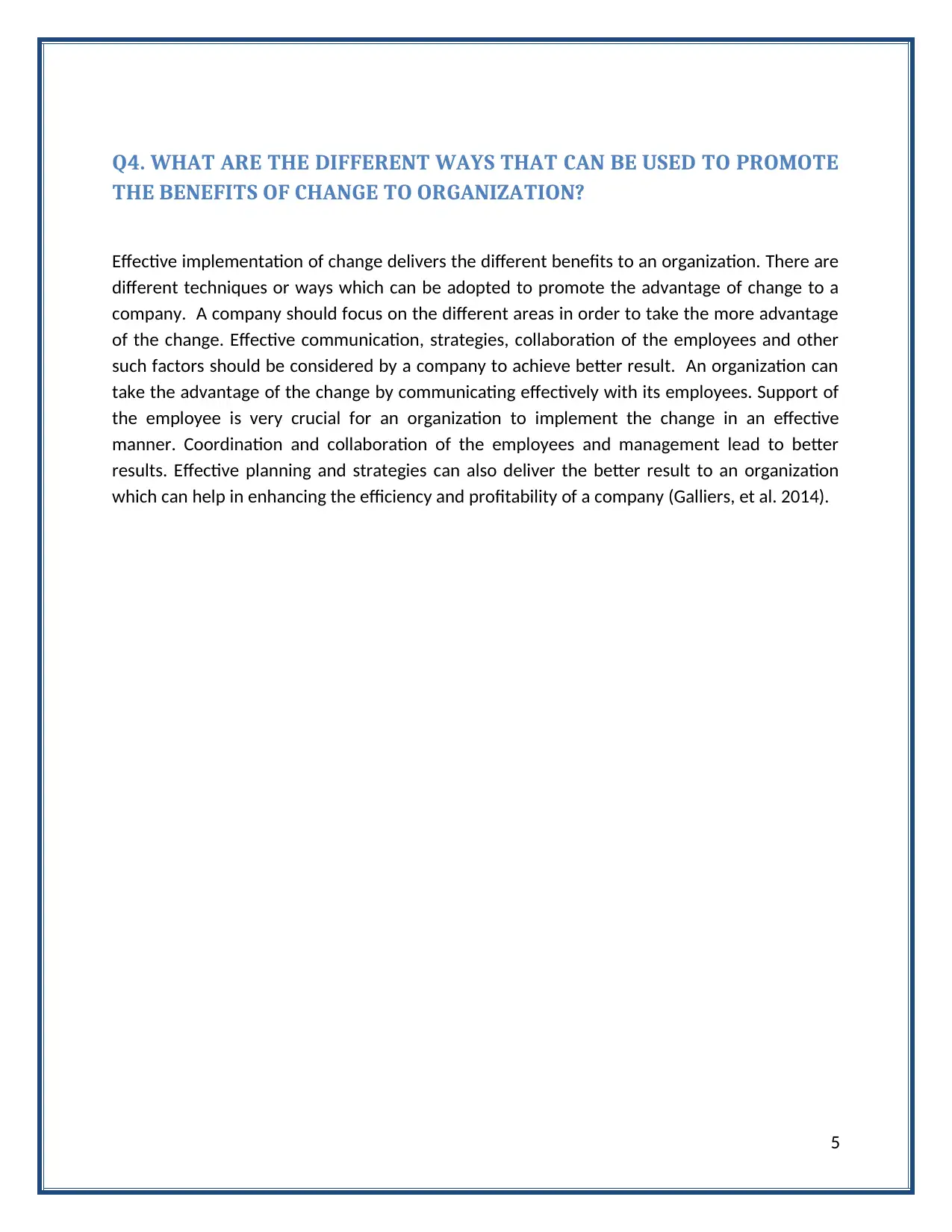
Q4. WHAT ARE THE DIFFERENT WAYS THAT CAN BE USED TO PROMOTE
THE BENEFITS OF CHANGE TO ORGANIZATION?
Effective implementation of change delivers the different benefits to an organization. There are
different techniques or ways which can be adopted to promote the advantage of change to a
company. A company should focus on the different areas in order to take the more advantage
of the change. Effective communication, strategies, collaboration of the employees and other
such factors should be considered by a company to achieve better result. An organization can
take the advantage of the change by communicating effectively with its employees. Support of
the employee is very crucial for an organization to implement the change in an effective
manner. Coordination and collaboration of the employees and management lead to better
results. Effective planning and strategies can also deliver the better result to an organization
which can help in enhancing the efficiency and profitability of a company (Galliers, et al. 2014).
5
THE BENEFITS OF CHANGE TO ORGANIZATION?
Effective implementation of change delivers the different benefits to an organization. There are
different techniques or ways which can be adopted to promote the advantage of change to a
company. A company should focus on the different areas in order to take the more advantage
of the change. Effective communication, strategies, collaboration of the employees and other
such factors should be considered by a company to achieve better result. An organization can
take the advantage of the change by communicating effectively with its employees. Support of
the employee is very crucial for an organization to implement the change in an effective
manner. Coordination and collaboration of the employees and management lead to better
results. Effective planning and strategies can also deliver the better result to an organization
which can help in enhancing the efficiency and profitability of a company (Galliers, et al. 2014).
5
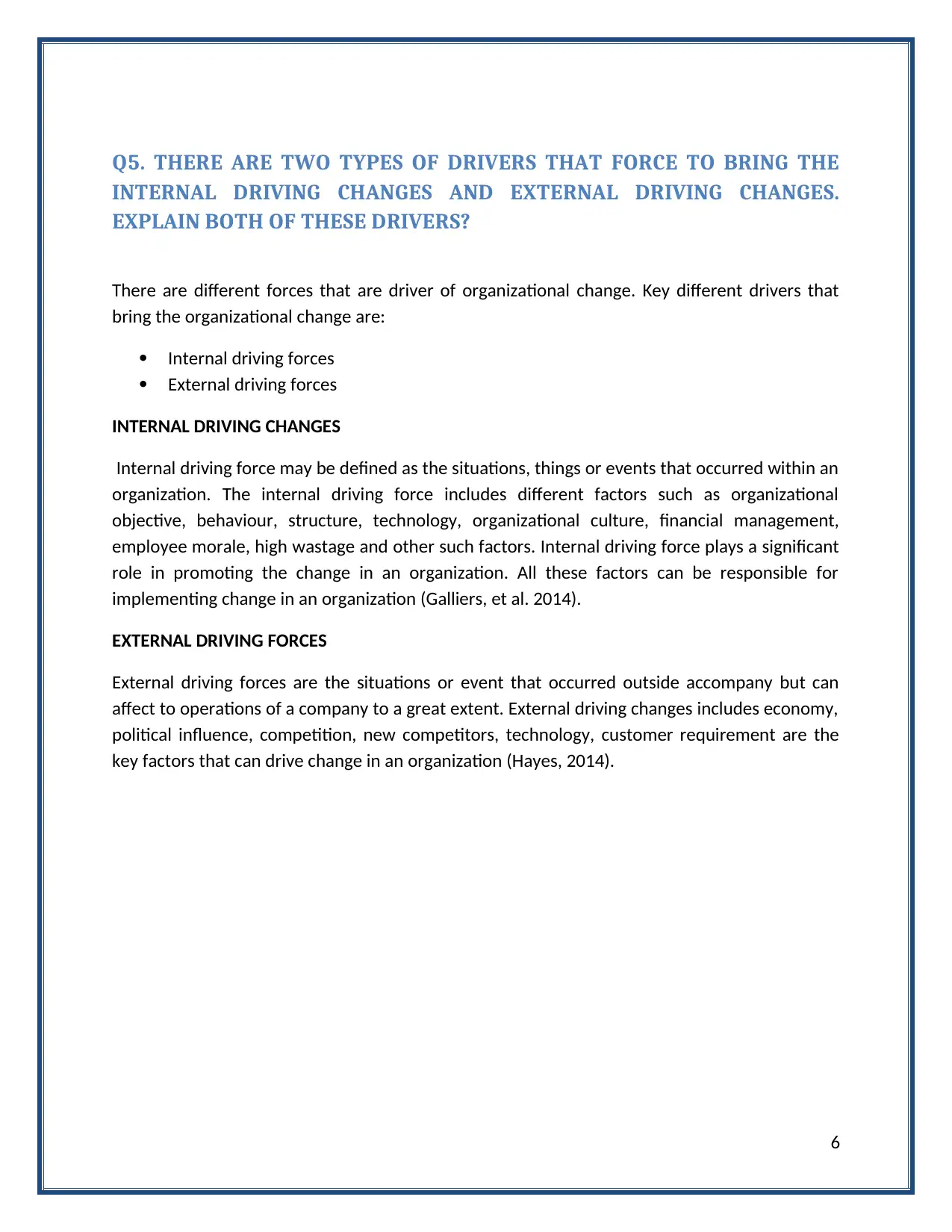
Q5. THERE ARE TWO TYPES OF DRIVERS THAT FORCE TO BRING THE
INTERNAL DRIVING CHANGES AND EXTERNAL DRIVING CHANGES.
EXPLAIN BOTH OF THESE DRIVERS?
There are different forces that are driver of organizational change. Key different drivers that
bring the organizational change are:
Internal driving forces
External driving forces
INTERNAL DRIVING CHANGES
Internal driving force may be defined as the situations, things or events that occurred within an
organization. The internal driving force includes different factors such as organizational
objective, behaviour, structure, technology, organizational culture, financial management,
employee morale, high wastage and other such factors. Internal driving force plays a significant
role in promoting the change in an organization. All these factors can be responsible for
implementing change in an organization (Galliers, et al. 2014).
EXTERNAL DRIVING FORCES
External driving forces are the situations or event that occurred outside accompany but can
affect to operations of a company to a great extent. External driving changes includes economy,
political influence, competition, new competitors, technology, customer requirement are the
key factors that can drive change in an organization (Hayes, 2014).
6
INTERNAL DRIVING CHANGES AND EXTERNAL DRIVING CHANGES.
EXPLAIN BOTH OF THESE DRIVERS?
There are different forces that are driver of organizational change. Key different drivers that
bring the organizational change are:
Internal driving forces
External driving forces
INTERNAL DRIVING CHANGES
Internal driving force may be defined as the situations, things or events that occurred within an
organization. The internal driving force includes different factors such as organizational
objective, behaviour, structure, technology, organizational culture, financial management,
employee morale, high wastage and other such factors. Internal driving force plays a significant
role in promoting the change in an organization. All these factors can be responsible for
implementing change in an organization (Galliers, et al. 2014).
EXTERNAL DRIVING FORCES
External driving forces are the situations or event that occurred outside accompany but can
affect to operations of a company to a great extent. External driving changes includes economy,
political influence, competition, new competitors, technology, customer requirement are the
key factors that can drive change in an organization (Hayes, 2014).
6
⊘ This is a preview!⊘
Do you want full access?
Subscribe today to unlock all pages.

Trusted by 1+ million students worldwide
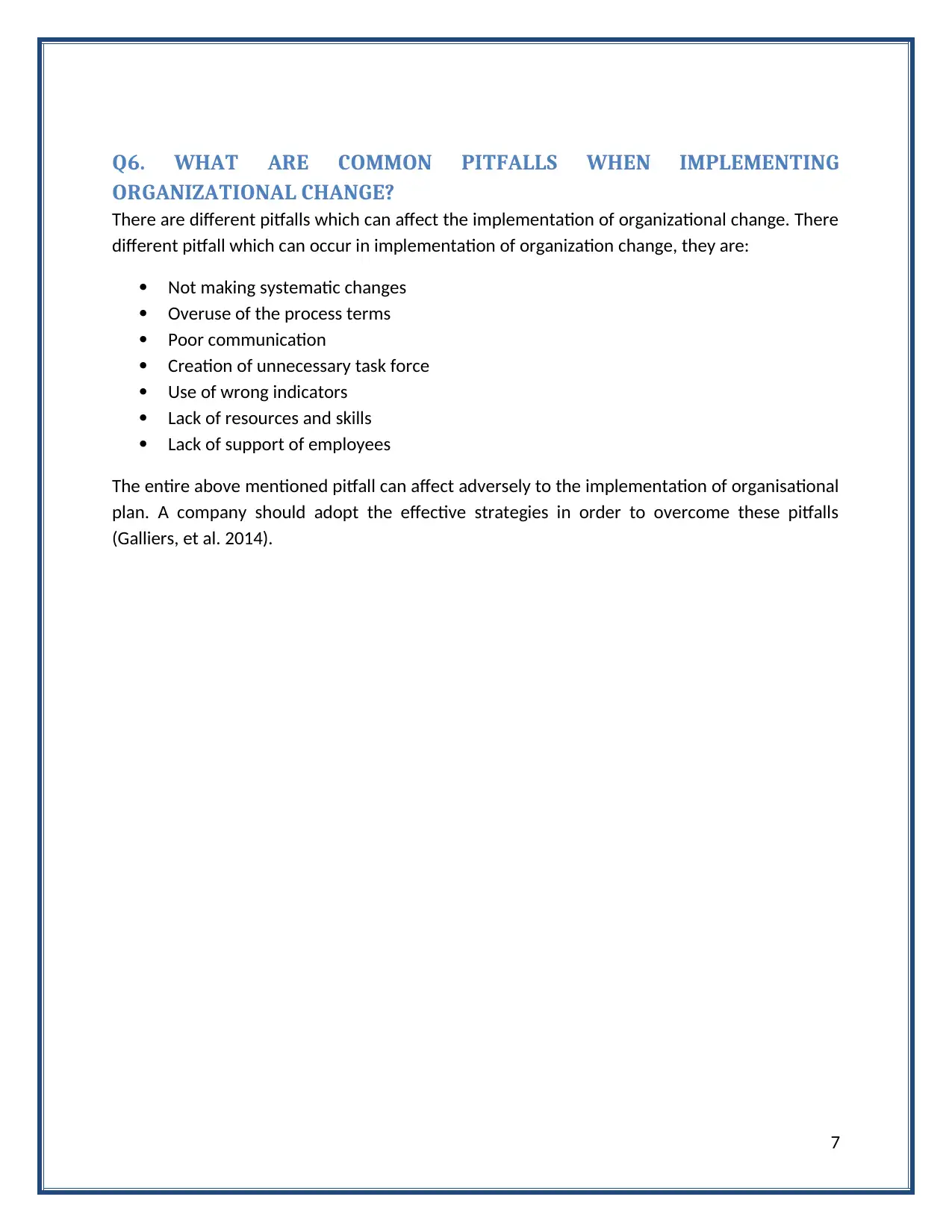
Q6. WHAT ARE COMMON PITFALLS WHEN IMPLEMENTING
ORGANIZATIONAL CHANGE?
There are different pitfalls which can affect the implementation of organizational change. There
different pitfall which can occur in implementation of organization change, they are:
Not making systematic changes
Overuse of the process terms
Poor communication
Creation of unnecessary task force
Use of wrong indicators
Lack of resources and skills
Lack of support of employees
The entire above mentioned pitfall can affect adversely to the implementation of organisational
plan. A company should adopt the effective strategies in order to overcome these pitfalls
(Galliers, et al. 2014).
7
ORGANIZATIONAL CHANGE?
There are different pitfalls which can affect the implementation of organizational change. There
different pitfall which can occur in implementation of organization change, they are:
Not making systematic changes
Overuse of the process terms
Poor communication
Creation of unnecessary task force
Use of wrong indicators
Lack of resources and skills
Lack of support of employees
The entire above mentioned pitfall can affect adversely to the implementation of organisational
plan. A company should adopt the effective strategies in order to overcome these pitfalls
(Galliers, et al. 2014).
7
Paraphrase This Document
Need a fresh take? Get an instant paraphrase of this document with our AI Paraphraser
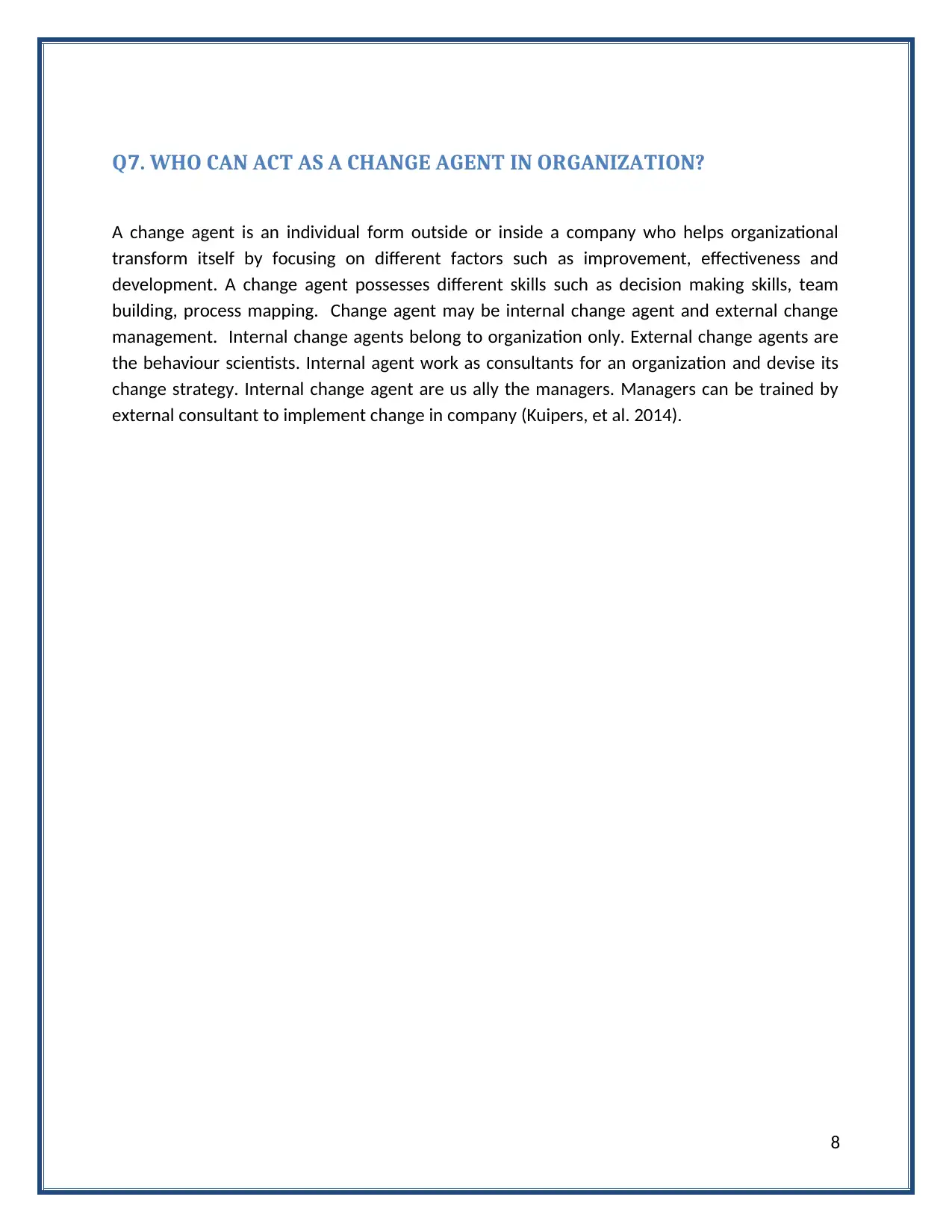
Q7. WHO CAN ACT AS A CHANGE AGENT IN ORGANIZATION?
A change agent is an individual form outside or inside a company who helps organizational
transform itself by focusing on different factors such as improvement, effectiveness and
development. A change agent possesses different skills such as decision making skills, team
building, process mapping. Change agent may be internal change agent and external change
management. Internal change agents belong to organization only. External change agents are
the behaviour scientists. Internal agent work as consultants for an organization and devise its
change strategy. Internal change agent are us ally the managers. Managers can be trained by
external consultant to implement change in company (Kuipers, et al. 2014).
8
A change agent is an individual form outside or inside a company who helps organizational
transform itself by focusing on different factors such as improvement, effectiveness and
development. A change agent possesses different skills such as decision making skills, team
building, process mapping. Change agent may be internal change agent and external change
management. Internal change agents belong to organization only. External change agents are
the behaviour scientists. Internal agent work as consultants for an organization and devise its
change strategy. Internal change agent are us ally the managers. Managers can be trained by
external consultant to implement change in company (Kuipers, et al. 2014).
8
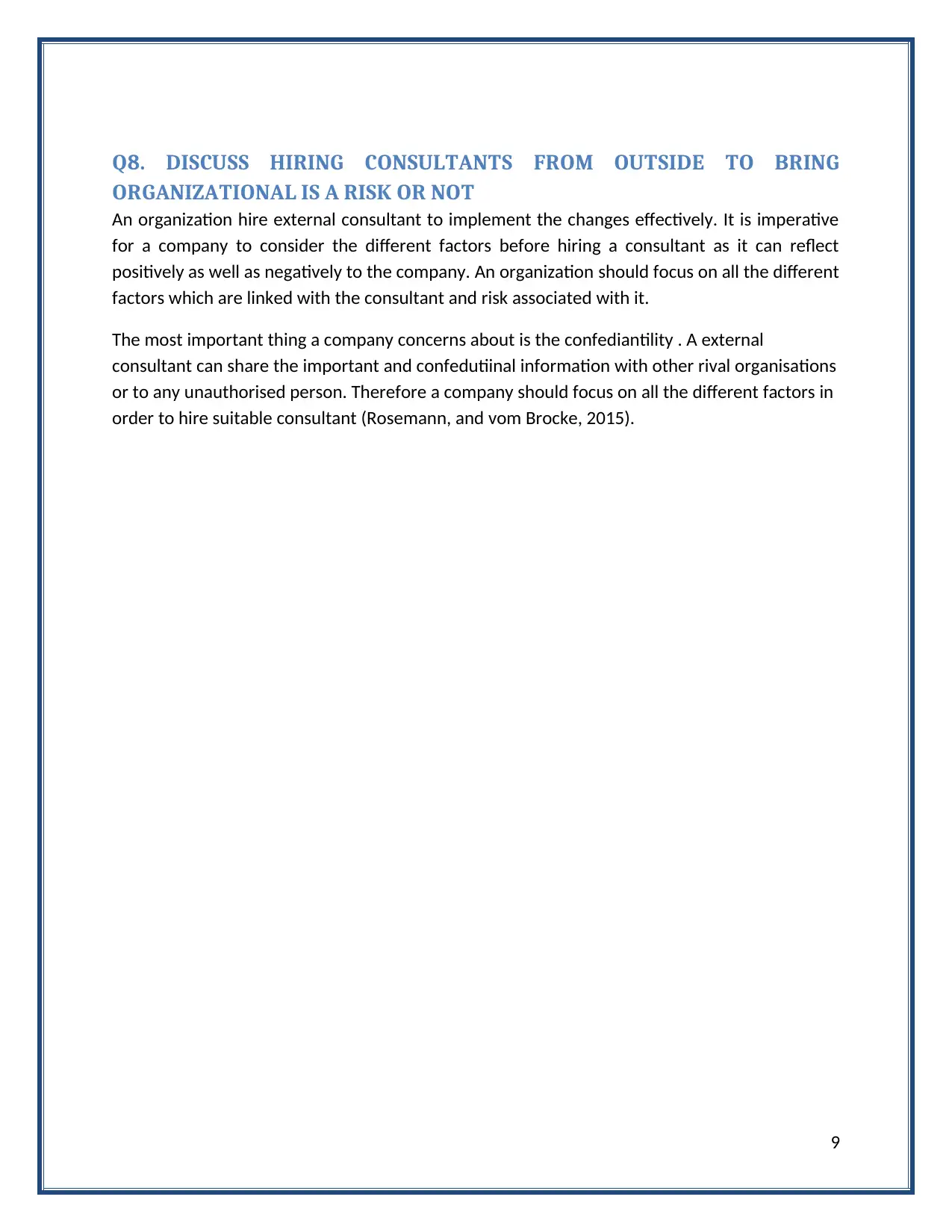
Q8. DISCUSS HIRING CONSULTANTS FROM OUTSIDE TO BRING
ORGANIZATIONAL IS A RISK OR NOT
An organization hire external consultant to implement the changes effectively. It is imperative
for a company to consider the different factors before hiring a consultant as it can reflect
positively as well as negatively to the company. An organization should focus on all the different
factors which are linked with the consultant and risk associated with it.
The most important thing a company concerns about is the confediantility . A external
consultant can share the important and confedutiinal information with other rival organisations
or to any unauthorised person. Therefore a company should focus on all the different factors in
order to hire suitable consultant (Rosemann, and vom Brocke, 2015).
9
ORGANIZATIONAL IS A RISK OR NOT
An organization hire external consultant to implement the changes effectively. It is imperative
for a company to consider the different factors before hiring a consultant as it can reflect
positively as well as negatively to the company. An organization should focus on all the different
factors which are linked with the consultant and risk associated with it.
The most important thing a company concerns about is the confediantility . A external
consultant can share the important and confedutiinal information with other rival organisations
or to any unauthorised person. Therefore a company should focus on all the different factors in
order to hire suitable consultant (Rosemann, and vom Brocke, 2015).
9
⊘ This is a preview!⊘
Do you want full access?
Subscribe today to unlock all pages.

Trusted by 1+ million students worldwide
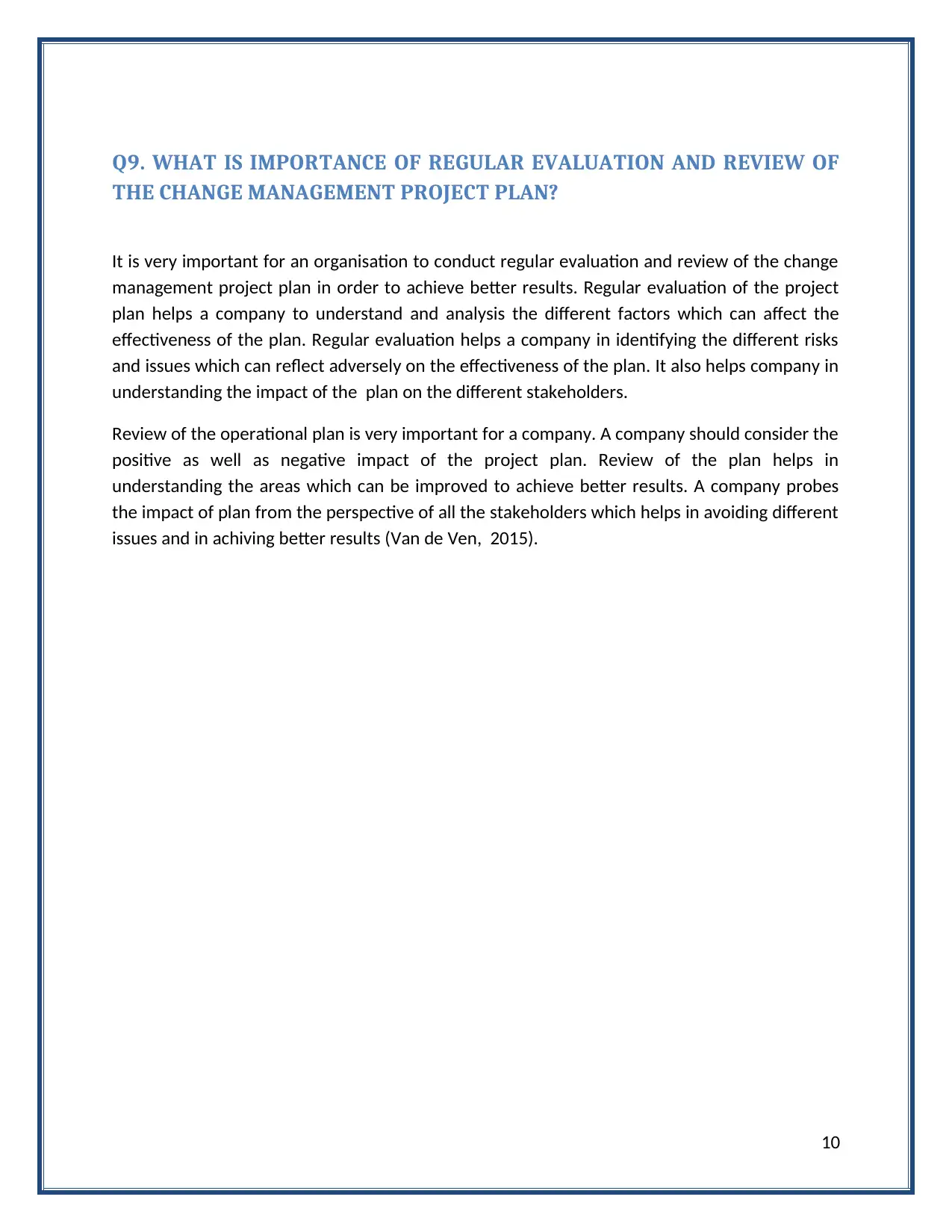
Q9. WHAT IS IMPORTANCE OF REGULAR EVALUATION AND REVIEW OF
THE CHANGE MANAGEMENT PROJECT PLAN?
It is very important for an organisation to conduct regular evaluation and review of the change
management project plan in order to achieve better results. Regular evaluation of the project
plan helps a company to understand and analysis the different factors which can affect the
effectiveness of the plan. Regular evaluation helps a company in identifying the different risks
and issues which can reflect adversely on the effectiveness of the plan. It also helps company in
understanding the impact of the plan on the different stakeholders.
Review of the operational plan is very important for a company. A company should consider the
positive as well as negative impact of the project plan. Review of the plan helps in
understanding the areas which can be improved to achieve better results. A company probes
the impact of plan from the perspective of all the stakeholders which helps in avoiding different
issues and in achiving better results (Van de Ven, 2015).
10
THE CHANGE MANAGEMENT PROJECT PLAN?
It is very important for an organisation to conduct regular evaluation and review of the change
management project plan in order to achieve better results. Regular evaluation of the project
plan helps a company to understand and analysis the different factors which can affect the
effectiveness of the plan. Regular evaluation helps a company in identifying the different risks
and issues which can reflect adversely on the effectiveness of the plan. It also helps company in
understanding the impact of the plan on the different stakeholders.
Review of the operational plan is very important for a company. A company should consider the
positive as well as negative impact of the project plan. Review of the plan helps in
understanding the areas which can be improved to achieve better results. A company probes
the impact of plan from the perspective of all the stakeholders which helps in avoiding different
issues and in achiving better results (Van de Ven, 2015).
10
Paraphrase This Document
Need a fresh take? Get an instant paraphrase of this document with our AI Paraphraser
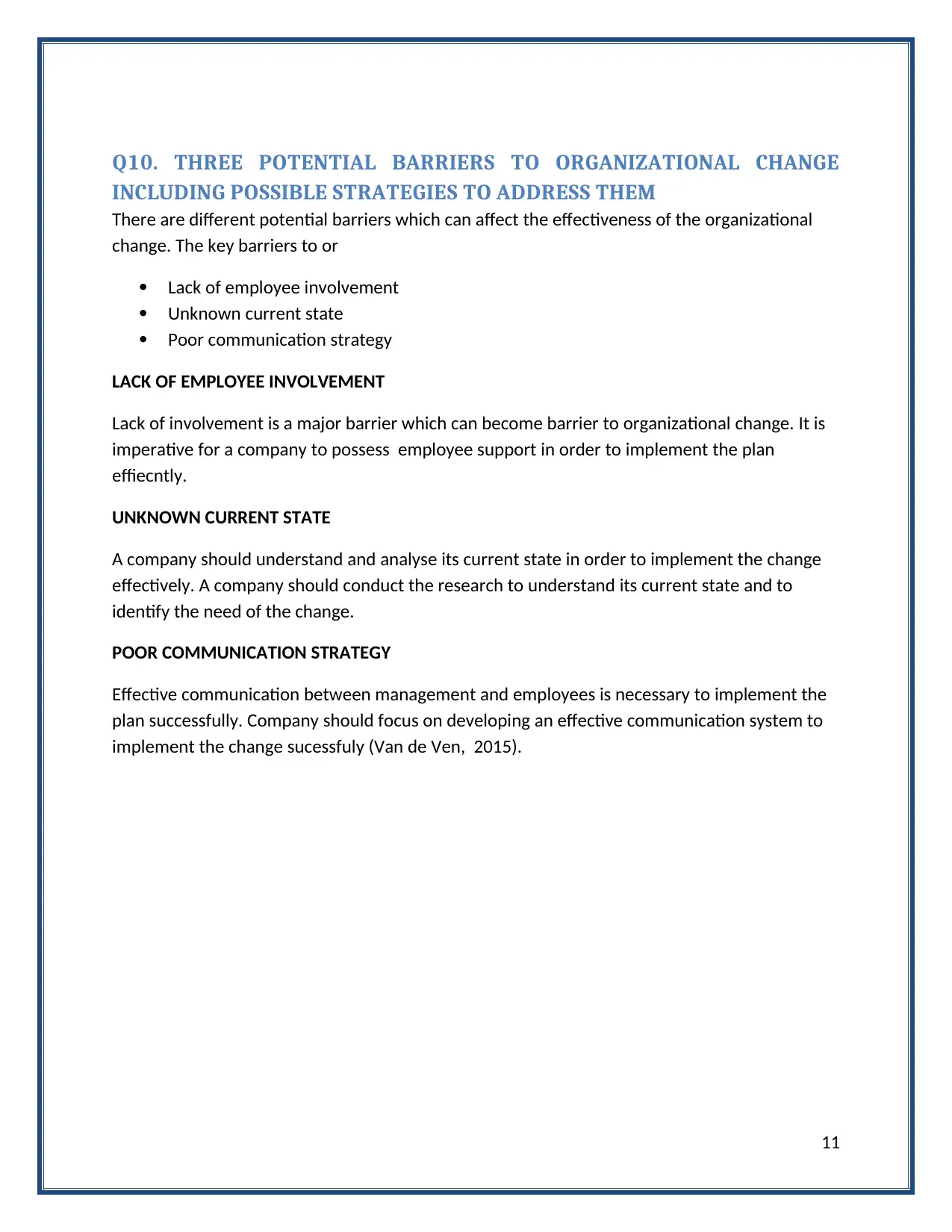
Q10. THREE POTENTIAL BARRIERS TO ORGANIZATIONAL CHANGE
INCLUDING POSSIBLE STRATEGIES TO ADDRESS THEM
There are different potential barriers which can affect the effectiveness of the organizational
change. The key barriers to or
Lack of employee involvement
Unknown current state
Poor communication strategy
LACK OF EMPLOYEE INVOLVEMENT
Lack of involvement is a major barrier which can become barrier to organizational change. It is
imperative for a company to possess employee support in order to implement the plan
effiecntly.
UNKNOWN CURRENT STATE
A company should understand and analyse its current state in order to implement the change
effectively. A company should conduct the research to understand its current state and to
identify the need of the change.
POOR COMMUNICATION STRATEGY
Effective communication between management and employees is necessary to implement the
plan successfully. Company should focus on developing an effective communication system to
implement the change sucessfuly (Van de Ven, 2015).
11
INCLUDING POSSIBLE STRATEGIES TO ADDRESS THEM
There are different potential barriers which can affect the effectiveness of the organizational
change. The key barriers to or
Lack of employee involvement
Unknown current state
Poor communication strategy
LACK OF EMPLOYEE INVOLVEMENT
Lack of involvement is a major barrier which can become barrier to organizational change. It is
imperative for a company to possess employee support in order to implement the plan
effiecntly.
UNKNOWN CURRENT STATE
A company should understand and analyse its current state in order to implement the change
effectively. A company should conduct the research to understand its current state and to
identify the need of the change.
POOR COMMUNICATION STRATEGY
Effective communication between management and employees is necessary to implement the
plan successfully. Company should focus on developing an effective communication system to
implement the change sucessfuly (Van de Ven, 2015).
11
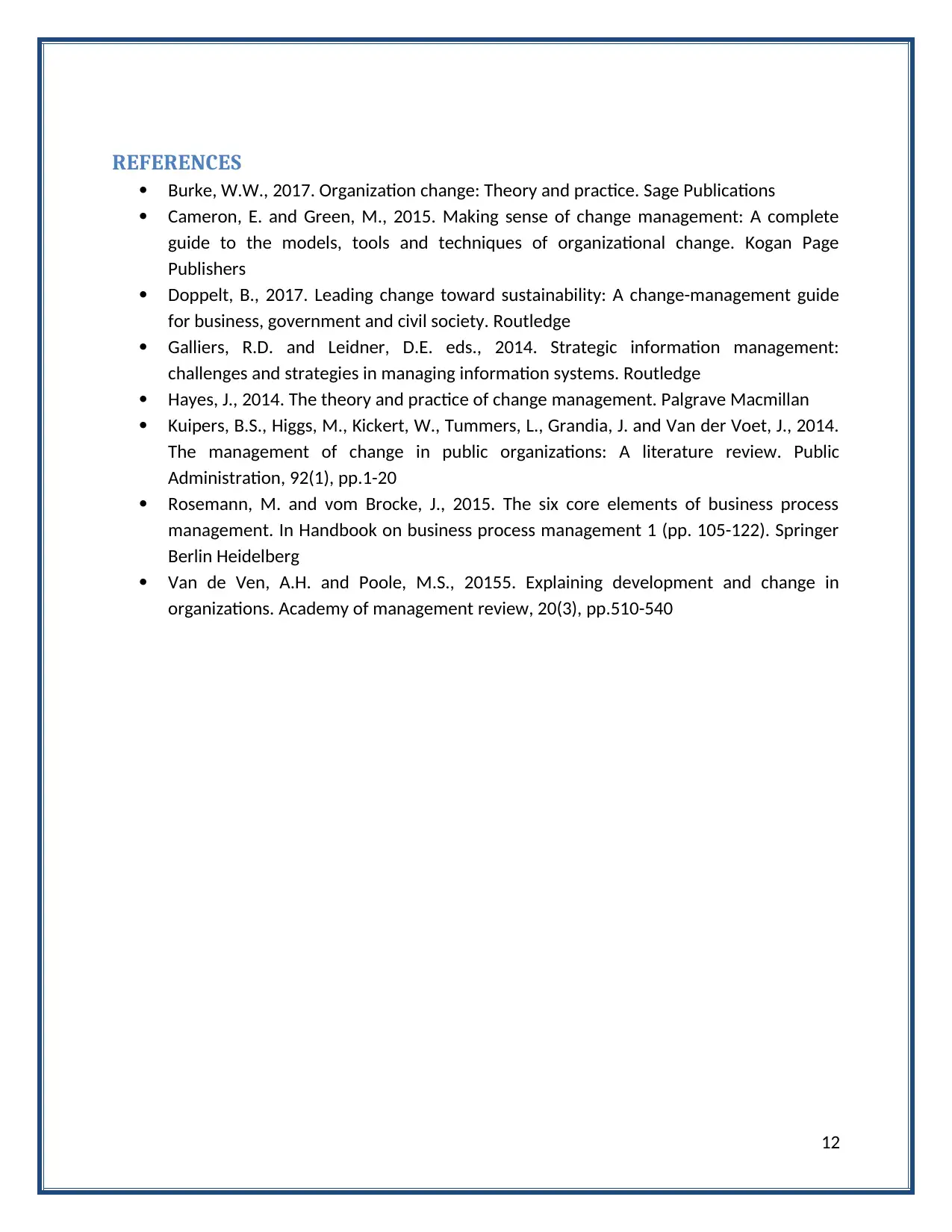
REFERENCES
Burke, W.W., 2017. Organization change: Theory and practice. Sage Publications
Cameron, E. and Green, M., 2015. Making sense of change management: A complete
guide to the models, tools and techniques of organizational change. Kogan Page
Publishers
Doppelt, B., 2017. Leading change toward sustainability: A change-management guide
for business, government and civil society. Routledge
Galliers, R.D. and Leidner, D.E. eds., 2014. Strategic information management:
challenges and strategies in managing information systems. Routledge
Hayes, J., 2014. The theory and practice of change management. Palgrave Macmillan
Kuipers, B.S., Higgs, M., Kickert, W., Tummers, L., Grandia, J. and Van der Voet, J., 2014.
The management of change in public organizations: A literature review. Public
Administration, 92(1), pp.1-20
Rosemann, M. and vom Brocke, J., 2015. The six core elements of business process
management. In Handbook on business process management 1 (pp. 105-122). Springer
Berlin Heidelberg
Van de Ven, A.H. and Poole, M.S., 20155. Explaining development and change in
organizations. Academy of management review, 20(3), pp.510-540
12
Burke, W.W., 2017. Organization change: Theory and practice. Sage Publications
Cameron, E. and Green, M., 2015. Making sense of change management: A complete
guide to the models, tools and techniques of organizational change. Kogan Page
Publishers
Doppelt, B., 2017. Leading change toward sustainability: A change-management guide
for business, government and civil society. Routledge
Galliers, R.D. and Leidner, D.E. eds., 2014. Strategic information management:
challenges and strategies in managing information systems. Routledge
Hayes, J., 2014. The theory and practice of change management. Palgrave Macmillan
Kuipers, B.S., Higgs, M., Kickert, W., Tummers, L., Grandia, J. and Van der Voet, J., 2014.
The management of change in public organizations: A literature review. Public
Administration, 92(1), pp.1-20
Rosemann, M. and vom Brocke, J., 2015. The six core elements of business process
management. In Handbook on business process management 1 (pp. 105-122). Springer
Berlin Heidelberg
Van de Ven, A.H. and Poole, M.S., 20155. Explaining development and change in
organizations. Academy of management review, 20(3), pp.510-540
12
⊘ This is a preview!⊘
Do you want full access?
Subscribe today to unlock all pages.

Trusted by 1+ million students worldwide
1 out of 13
Related Documents
Your All-in-One AI-Powered Toolkit for Academic Success.
+13062052269
info@desklib.com
Available 24*7 on WhatsApp / Email
![[object Object]](/_next/static/media/star-bottom.7253800d.svg)
Unlock your academic potential
Copyright © 2020–2025 A2Z Services. All Rights Reserved. Developed and managed by ZUCOL.





